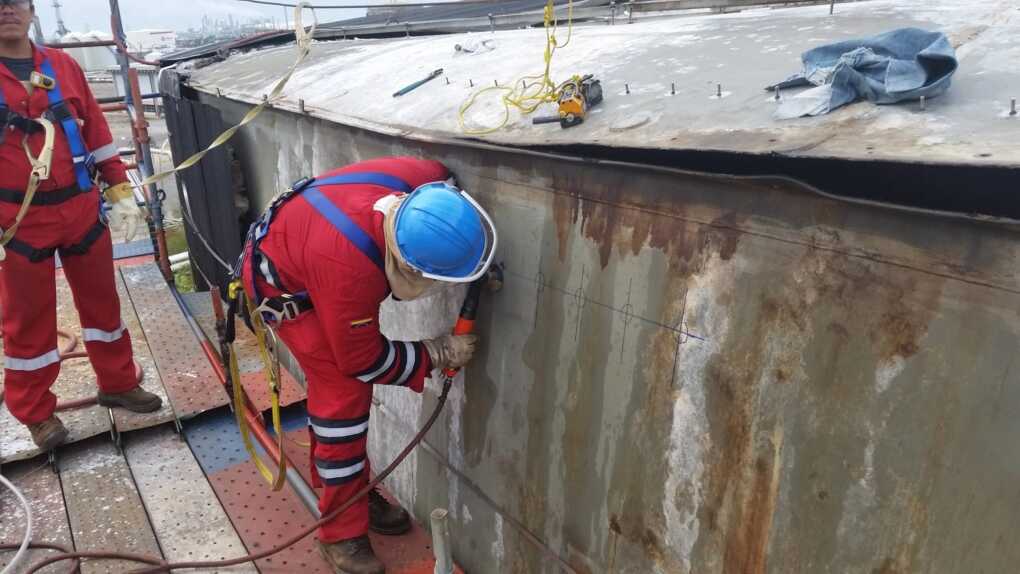
Why Commercial Tanks Need More Than Basic Maintenance
In an industrial environment, storage tanks are some of the most heavily used and heavily stressed assets on the property. They hold chemicals, fuels, oils, wastewater, and other commercial materials that constantly interact with steel, coatings, valves, and internal surfaces. Over time, these interactions create structural pressure that eventually requires storage tank repair to keep the tank safe and operational.
Facilities rely on these tanks daily, and even a small problem can lead to operational delays or safety risks. Repairs aren’t just about fixing visible issues—they’re about preventing failures that could trigger downtime, environmental cleanup, or regulatory action. When repairs are addressed early, companies avoid the steep costs that accompany major structural breakdowns.
How Tanks Begin to Deteriorate Inside Industrial Operations
A storage tank doesn’t fail all at once. It breaks down slowly, in ways that aren’t always visible. Temperature swings cause expansion and contraction. Internal sludge can trap moisture against the steel. Chemical reactions gradually weaken coatings. When these factors stack up, the internal and external structure changes.
Common contributors to deterioration include:
- Fluctuating internal pressures
- Chemical corrosion from stored materials
- Long-term exposure to moisture or humidity
- Inconsistent maintenance schedules
- Temperature extremes in outdoor installations
All of these elements culminate in the need for storage tank repair before the tank becomes unsafe or unusable.
Warning Signs That Repairs Are Needed Immediately
Facility operators often notice changes before major failures occur. Early detection prevents the escalation of damage and protects the facility from costly emergency situations.
Signs that indicate a tank needs attention include:
- Visible rust or scaling on the tank exterior
- Product contamination or inconsistencies in stored material
- Slow product flow or clogged lines linked to internal buildup
- Strong odors suggesting vapor leakage
- Uneven tank settlement or shifting support structures
Any one of these issues warrants a full inspection, followed by targeted storage tank repair.
Why Repairs Must Be Performed by Qualified Teams
Commercial storage systems require repairs that go beyond basic welding or patchwork. Professional teams use advanced diagnostic tools to identify weaknesses, structural thinning, and early signs of tank failure. Their work ensures the tank remains safe under pressure and compliant with industrial standards.
Professional repair crews typically:
- Conduct ultrasonic thickness testing
- Use magnetic particle inspection to locate cracks
- Identify weld failures or seam weaknesses
- Assess protective coatings for deterioration
- Evaluate internal corrosion rates
These insights allow the repair team to determine what type of storage tank repair is necessary to stabilize and extend the tank’s operational life.
Types of Repairs Common in Industrial Storage Tanks
Not every tank will require the same type of repair. Different materials, different chemicals, and different operational loads create unique challenges.
Common repair approaches include:
- Welding reinforcement to strengthen weakened walls
- Restoring corroded or damaged weld seams
- Applying protective linings or coatings
- Replacing compromised sections of steel
- Repairing or replacing faulty vents, valves, or fittings
Each repair method is matched to the tank’s condition and the type of material it holds. Skilled technicians ensure all repairs meet the required industrial codes.
The Impact Repairs Have on Facility Performance
A tank that receives timely repairs supports the rest of the facility’s equipment, allowing production systems to operate efficiently. Clean flow rates improve, pumps run with less resistance, and sensors return more accurate readings. Repairs don’t just restore the tank—they improve the overall performance of connected systems.
Facilities often experience:
- More stable product flow
- Fewer pump or filtration issues
- Lower maintenance frequency
- Reduced risk of contamination
- Longer equipment lifespan across the network
These benefits show why storage tank repair is essential to maintaining smooth industrial operations.
How Repairs Help Maintain Environmental and Safety Compliance
Industrial tanks storing fuels and chemicals face strict regulatory oversight. Any leak or structural failure can trigger environmental investigations, fines, or shutdowns.
Effective storage tank repair contributes to compliance by:
- Restoring structural integrity before inspection dates
- Aligning tank conditions with environmental regulations
- Ensuring hazardous materials remain fully contained
- Minimizing risk of ground or water contamination
- Supporting documentation for regulatory audits
When repairs are well-documented and professionally executed, facilities stay compliant and avoid costly penalties.
The Role of Preventive Repair Planning
Commercial sites that plan repairs proactively experience fewer emergencies and more predictable operating conditions. Instead of reacting to failures, they integrate repairs into a long-term maintenance cycle.
Repair planning often includes:
- Annual internal inspections
- Scheduled coating renewals
- Routine corrosion evaluations
- Tank cleaning before structural assessments
- Predictive modeling based on historical wear data
Facilities that treat storage tank repair as part of ongoing asset management preserve tank strength and delay the need for full replacements.
Why Early Repairs Save Costs Over the Tank’s Lifetime
The price difference between early repair and emergency repair is significant. Early interventions reinforce weakened areas before failure. Emergency repair, on the other hand, often requires tank shutdown, replacement of multiple components, or full reconstruction of damaged sections.
Early repairs reduce costs by:
- Preventing structural collapse
- Avoiding contamination cleanup
- Reducing pump and line damage
- Extending total tank life
- Minimizing downtime
With proper planning, a single tank can serve a facility for decades, supported by consistent storage tank repair applied at the right stages.
Protecting Operational Stability Through Strategic Repairs
Industrial facilities depend on tanks that perform reliably every day. Repairs reinforce the tank’s structure, support environmental safety standards, and ensure that the system continues operating without disruption. When storage tanks receive the right repairs at the right time, they remain safe, dependable, and fully aligned with industrial demands.
Through consistent maintenance and targeted storage tank repair, facilities protect their investment, their workforce, and their long-term production capabilities.
